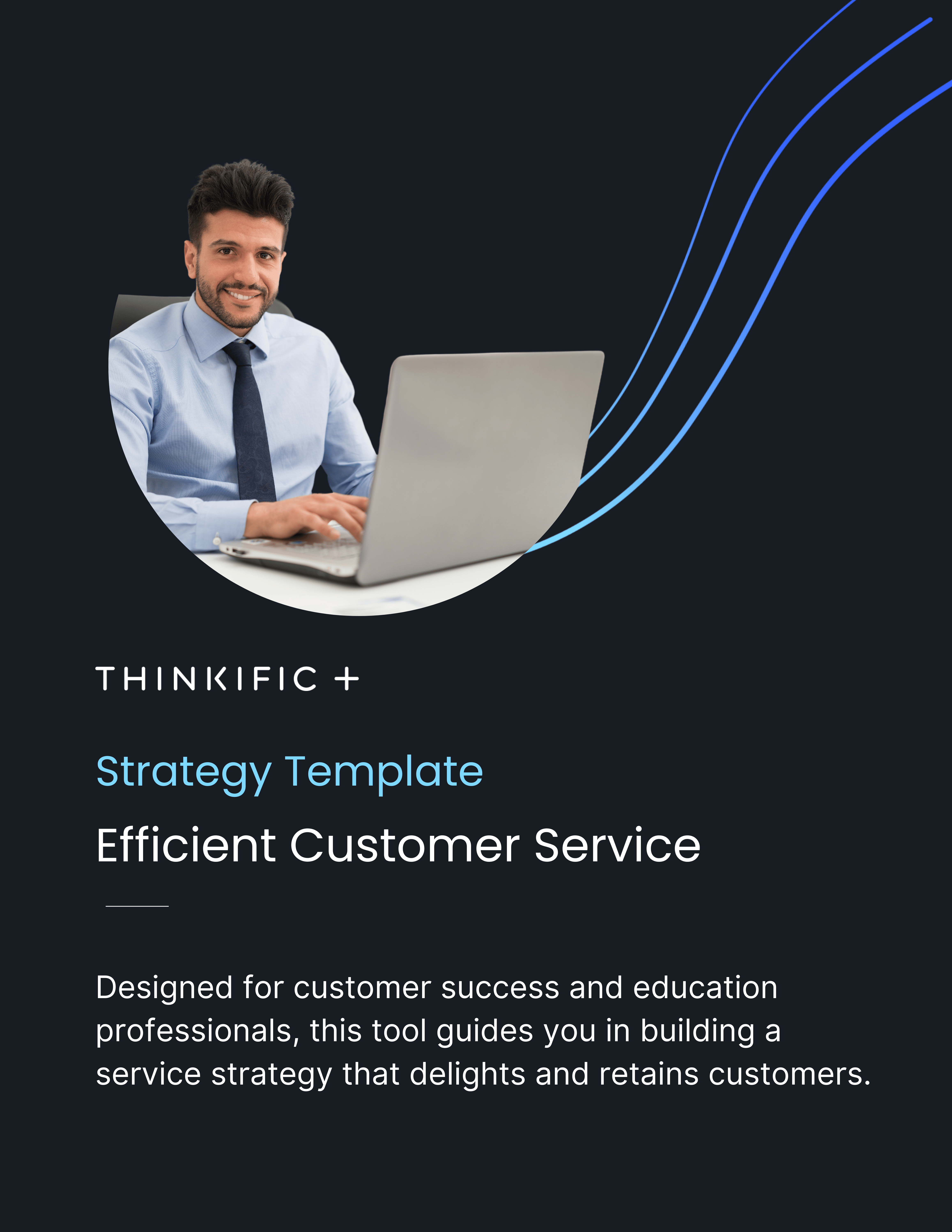What comes to mind when you think of an amazing customer service strategy? Is it high levels of personalization and support? A great bonus and rewards system? Or speedy replies and prompt follow up?
One of the most important pillars of running your own business is having an effective customer service plan to increase customer retention and customer lifetime value (CLV). Ultimately, you want to create a pleasant journey of service interactions for customers before and after purchasing, so that your business remains number one in their eyes.
Whether you are just getting your business up and off the ground or if you are an established company looking to make a few tweaks, this guide will go through the details of a customer service strategy template that will forever change the way you approach your business plan. Remember, satisfied and happy customers = a very successful business!
Keep reading or skip ahead:
- Introduction to customer service strategy
- Defining your customer service vision
- Building your customer service team
- Developing your customer service process
- Selecting the right tools and software
- Setting goals and measuring success
- Conclusion
- FAQs
Ready to learn more? Let’s dive in!
Related: SaaS Support Strategy: Best Practices for Exceptional Customer Support
Download our Customer Service Strategy Template to kickstart your journey to delivering exceptional customer experiences using our step-by-step guide to enhancing customer support.
Introduction to customer service strategy
So, what exactly is a customer service strategy, and how can you implement a customer support strategy framework into your business?
A customer service strategy is essentially a detailed plan to flawlessly facilitate and handle all customer interactions with your business. This includes targeting customers effectively before they connect with your business, and also conscientiously following up afterwards.
This customer-centric thought process won’t go unnoticed by your target audience, and soon after implementing this customer service strategy template, your customer satisfaction levels will increase and loyalty rates will subsequently rise.
Importance of a structured customer service approach
Without a customer service improvement plan in your organization, it comes easy to get lost in the chaos of running a business. Think of your customer service strategy template as the glue that holds together all the pieces that are important for ensuring there is no disconnect between your business and your customers.
It’s vital for your business’s success to have a customer service strategy development in place, as this will spur growth and scalability within your business.
A solid strategy will support higher customer lifetime value and promote a strong brand reputation. It will also help build consistency among your consumers and streamline customer support and feedback processes for your employees.
Overview of the template’s benefits
A customer service strategy template is beneficial for both businesses and customers. It improves customer experiences and business processes for companies of any shape and size, and in any industry. Think of a customer service strategy template like the blueprints to a building – this sets the foundation, and is the map to creating a well-run and successful business. It displays all of the crucial elements of customer service neatly in a document that you can easily refer back to for your business needs.
Simply put, a customer service plan serves as a roadmap for streamlining and strengthening customer support. It gives employees clear instructions, helps your business understand customer needs and where to allocate resources, and provides insights for continuous improvement. It benefits both businesses and customers.
Creating a customer service strategy template offers many benefits, including:
- Creates a uniform process – Having a customer service strategy template in place allows for everyone in your business to be on the same page, delivering a consistent customer experience.
- Fosters accountability – Creating a plan allows your organization to be proactive rather than reactive.
- Increases operational efficiency – This template will help your business establish (and stick to) goals that optimize customer experiences.
- Stimulates business growth – Delivering excellent customer service can drive sales and revenue, and a solid template will facilitate this.
- Empowers businesses and customers – A well thought out plan will make your employees lives easier while increasing customer engagement and loyalty, building more brand trust.
- Problem resolution – Referring back to a template will allow for better crisis management when processes go sideways.
- Improves satisfaction and retention – Customers will receive reliable, high-quality experiences when your business follows a strategic customer service improvement plan. This will enhance your customer relationships and establish trust.
Now, let’s explore important elements that make up a customer service strategy template.
Related: What Is Customer Lifetime Value (CLV) and Why Does It Matter?
Defining your customer service vision
Before you get started filling in your customer service strategy template, it’s important to think about the vision you have for your customers… What message are you trying to convey to potential customers? How do you want them to feel after interacting with your brand? Defining your vision will help you identify, clarify, and narrow down your service strategy development goals.
Crafting a customer-focused vision statement
Think about these elements when crafting your customer-focused vision statement:
- Reflect on the mission of your company
- Research your target audience’s values
- Make it meaningful for your business and customers
- Ensure your customer service team can influence and control the statement
- Outline the long-term goals of your customer service strategy
Customer service vision statement example: “To deliver exceptional service that exceeds customer expectations at every touchpoint.”
A vision statement informs the morale and spirit of your business, and it dictates your customer interaction guidelines. Ultimately, you’ll want your vision statement to be inspiring to your audience.
Aligning service goals with business objectives
Making sure that your customer support strategy framework aligns with your business objectives will help ensure that your customer service template supports the strategic vision of your organization, helping deliver value to your consumers.
To align your service goals, think about the needs of your customers and your employees. This means identifying your target customers and their expectations, pain points, and their value drivers. It also means understanding your business vision, mission, objectives, and priorities.
Building your customer service team
In order to deliver excellent customer service, you need to establish a well-trained and knowledgeable customer service team. This is one of the most important aspects in your customer service strategy template, as who you have on your team is a direct reflection of your brand’s mission and values in the eyes of your customers.
Structuring your support team for maximum efficiency
Creating an effective and efficient support team is all about outstanding levels of communication. It involves assigning clearly defined roles to team members and communicating performance expectations so that everyone is on the same page about the customer service strategy. This allows everyone to understand what they are contributing and how they can all work towards the same goals.
Training and development strategies
When building your customer support team, use the following guideline:
- Share your business’s vision for the future
- Communicate customer service goals
- Value your employees thoughts and contributions
- Provide training resources
- Offer feedback and troubleshooting tips
- Establish performance expectations
- Develop a supportive customer service culture
Roles and responsibilities in a customer service team
The following table outlines possible roles and responsibilities in a customer support team:
| Roles | Responsibilities |
Managers
|
|
Customer Service Agents
|
|
Technical Support
|
|
Customer Success Manager
|
|
Customer Experience Manager
|
|
Related: Customer Success vs Customer Support: How To Use Both
Developing your customer service process
Now it’s time to start thinking about the steps to developing your customer service process, and what these touchpoints will look like for your business.
Key stages in the customer service journey
To build long-term customer relationships that result in customer satisfaction, ensure that your business optimizes these five stages of the customer journey:
- Awareness – Your target audience notices and gathers information about your brand’s products and services.
- Consideration – Potential customers begin to consider your brand as a solution, and they start comparing your business to competitors.
- Purchase – Customers are ready to make a buying decision.
- Retention – Now that you’ve converted a customer, focus on establishing a relationship through customer loyalty and driving repeat business.
- Advocacy – The customer is actively encouraging other people to make purchases.
Most customer journeys don’t have a distinct end, so brands should always treat everyone – potential customers and even the most loyal customers – with the same high-quality service that’ll keep customers in the advocacy stage.
Implementing effective communication channels
Customer communication is the interactions your business has with consumers, and is a vital step in your customer service strategy template. This is how your brand identifies touchpoints and builds a relationship at each one of them through various channels.
A great way to do this is to use omnichannel communication, which involves ensuring a continuous experience with no gaps, using various channels to connect with customers. It doesn’t matter if your customer contacts you through email, website, or multiple social media platforms – they’ll have the same amazing and supportive experience either way.
The key with implementing effective communication channels is to be consistent across all platforms, ensuring a seamless and smooth transition for customers. Trust us, if you do this well, your customers will subconsciously be impressed with the flawless ease of communication and advocate your brand to others!
Customer Service Process Checklist
A customer service checklist is a set of guidelines that an organization can reflect on to help deliver effective customer service and support team structure at various stages of the customer support journey.
This checklist may vary from company to company, but it includes all the necessary steps to improving customer experience and swiftly resolving any customer issues.
Here is an example of a customer service checklist:
- Create an accessible knowledge base for your customer support team
- Train your support team so they are on the same page
- Make sure customers can easily contact support
- Specify your hours of support and availability
- Setup and utilize a self-serve customer support tool
- Effectively support all customer needs
- Use positive language and be empathetic towards customer needs
- Be proactive with support measures
- Collect feedback from customers
- Focus on long-term customer relationships
- Evaluate customer service performance
- Complete this checklist!
Related: How to Reduce Churn (5 Strategies & Tips for Net Growth)
Selecting the right tools and software
In this digital age, it is essential for businesses to use technology to their advantage, especially when developing a customer service improvement plan. Customer service software is any program that helps a business provide support to their target audience who purchases products or services.
Overview of essential customer service tools
These are some of the essential customer service tools to consider adding to your customer service strategy template to help level-up your customer interactions:
- Knowledge bases
- Help desk ticketing system
- Live chat software
- Social media listening and monitoring tool
- Customer feedback surveys
- Messaging apps
- Automation software
- Analytics and reporting dashboards
- Community forums
- Project and incident management tool
- Bug software
Integrating technology for better service delivery
There are a ton of tools out there that you can incorporate into your customer service strategy template for high-quality service delivery that your consumers will appreciate.
This technology will help facilitate customer support, and is often integrated with customer relationship management (CRM) software which assists businesses with all kinds of customer interactions, from the first point of contact to purchasing and beyond.
It’s worthwhile to invest in reliable customer service tools, as this will support your team with all the details you need to know about who your customers are – including where they’re coming from and what they’re searching for – no matter what channel they are using.
Setting goals and measuring success
With any sort of performance template, it’s important to get goals to measure your growth and success! Take a look at the strategies below to integrate into your customer service strategy template.
Identifying key performance indicators (KPIs)
Customer service KPIs are key different metrics that help support your team’s ability to optimize and keep track of their performance. Essentially, KPIs measure customer success and help businesses understand customer interactions. KPIs will look different for every business, depending on company needs and goals.
Based on what customer service software you have in place, it can be easy and efficient to track, manage, and understand KPIs. Implementing these into your business will help you improve productivity, adjust operations, and better understand your customer relationships.
Here are some examples of KPIs for excellent customer service:
- Average first response time
- Occupancy
- Average resolution time
- First contact resolution
- Tickets handled per hour vs. tickets solved per hour
- Escalation rate
- Customer effort score
- Net Promoter Score (NPS)
- Customer churn and retention rate
- Customer Satisfaction Score (CSAT)
Regular review and improvement strategies
To ensure that your business is effectively improving your customer service strategy, it’s vital to regularly review your template and to improve strategies where needed.
Evaluating the quality of your customer service also ensures that you are consistently giving your customers the best service possible. It’s also helpful to develop and update an accessible online resource library with FAQs, tutorial videos, and informative articles for your customers.
Related: How To Create The Perfect Customer Journey Map (+ Template)
Conclusion
Having a customer service strategy in place is vital for the long-term success of your business. The best way to get started with your customer experience optimization is to utilize a customer service strategy template to streamline the process. This will help keep you from feeling overwhelmed, and organize all of your customer service metrics in one place.
To grow your business, download our FREE comprehensive template for customer service strategy so that you can start delivering exceptional experiences. This template will provide you with the tools needed to leverage your own resources and elevate your customer support, improve satisfaction, and build lasting customer loyalty.
Set your business and customers up for success
The best way to keep your customers happy is to make sure they’re getting the results they want from your product or service. That takes knowledge, and a Customer Training LMS Software is the only way to build that knowledge effectively at scale.
A Customer Training LMS Software will help you deliver excellent customer service and retain customers by keeping them engaged. Learn more about how you can achieve this with Thinkific Plus.
Thank you for exploring this guide to our customer service strategy template with us!
If you’re ready to take the next step and get personalized guidance to streamline your customer service strategy with online learning, get pricing details, and a live demo of Thinkific Plus, don’t hesitate to reach out to our experts.
Request a call with a member of our Thinkific Plus solutions team today, and let us help you unlock the full potential of your online learning journey.
FAQs
What is a customer service strategy template?
This customer service strategy template aims to help you develop a seamless, positive experience for every customer, driving satisfaction and loyalty. Continuous evaluation and improvement will keep your customer service aligned with evolving customer expectations and business goals.
How do you create an effective customer service strategy?
Make sure you plan ahead and use a quality template to help build and improve your customer service strategy. It’s never too early or late to get started, no matter where you are in your journey.
What are the key components of a customer service strategy?
To develop a robust customer service strategy, make sure you define your goals, identify customer touch points, establish a knowledgeable team, benchmark using customer service tools and KPIs, and continuously set goals and use feedback to measure success.
How often should a customer service strategy be reviewed?
Regular assessment and updates to your customer service strategy should be reviewed quarterly, and changes should be implemented based on your key performance metrics and through customer feedback.







